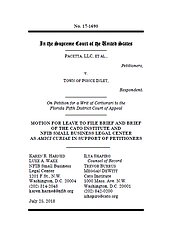Learn more about Cato’s Amicus Briefs Program.
Nearly a century has passed since Justice Oliver Wendell Holmes’s legendary proclamation that “while property may be regulated to a certain extent, if regulation goes too far it will be recognized as a taking.” But that statement did little to actually clarify when the Fifth Amendment’s protections against uncompensated takings of property applies to government action that regulates away the use of land rather than physically taking it through eminent domain.
Attempting to clear up that confusion, the Supreme Court 40 years ago handed down the now infamous Penn Central decision (involving the historic qualities of NYC’s Penn Central Station). Penn Central requires courts to go through a balancing test based on (1) the economic impact of the regulation, (2) the extent to which the regulation interferes with reasonable investment-backed expectations, and (3) the nature or character of the government action. Unfortunately, that’s a lot of words to give very little direction, so property owners, regulators, lawyers, and lower courts have been clamoring for meaningful guidance on those fact-bound, ad-hoc inquiries ever since.
As the story of Simone and Lyder Johnson illustrates, the Supreme Court needs to provide true guiding principles on regulatory takings. The Johnsons were drawn to Ponce Inlet, Florida, where they bought land and made plans to construct their dream home. Sensing that the town may be able to benefit, Ponce Inlet persuaded the Johnsons to expand their plans into “a delightful mixed-use waterfront development.”
Over several years, the Johnsons bought additional parcels while working hand-in-hand with the town. They were amenable to providing everything the town asked for, like a nature preserve and boat slip. After millions of dollars were spent, the town changed its mind, halted all work, denied permits, and went so far as to pass legislation prohibiting all development on the Johnsons’ property.
The Johnsons sued, claiming that Ponce Inlet’s actions amounted to a compensable taking. The state trial court agreed, but the appellate court reversed and sent the case back to determine if a taking had occurred based on the economic impact on the “parcel as a whole” (meaning all the Johnsons’ property, rather than the specific parcels the trial court had found to be left devoid of economic value).
The Johnsons—through companies collectively known as Pacetta—have now asked the U.S. Supreme Court to review their case. Cato, along with the NFIB Small Business Legal Center, filed a brief supporting that petition. The Supreme Court has consistently referred to the Penn Central factors as the North Star of regulatory-takings law but has done little to clarify the meaning of each factor or how they should be weighed relative to one another.
What we do know is that property owners almost always lose under Penn Central. Under that nebulous test, lower courts are free to use those malleable factors to find that what government is attempting to achieve through its regulations is so important that a taking has not occurred, regardless of the regulation’s economic impact on the owner or the extent of its interference with invest-backed expectations. Likewise, lower courts frequently find that the economic impact of a regulation is not quite drastic enough—despite destroying as much as 95% of a property’s value—to find that a taking occurred, despite the extent of interference with investment-backed expectations.
The Court should take up Pacetta v. Ponce Inlet and use it as an opportunity to clarify at least one aspect of property law: that when one of Penn Central’s three ad-hoc inquiries tips strongly in favor of the owner, a taking has occurred and compensation is due.
